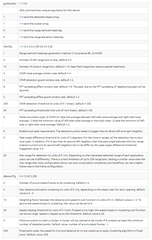I am having some trouble to configure the lab_004 of the automotive toolbox with a greater range. Using the default configuration the range is 0 to 2m, when accordingly to the calculus it should 11m like its explain in the following page: https://e2e.ti.com/support/sensors-group/sensors/f/sensors-forum/798393/faq-awr1642-maximum-range-range-resolution-in-obstacle-detection-demo.
Also, reading other discution in TI page, i realize i am not the only one with just 2m of range using the default configuration file: https://e2e.ti.com/support/sensors-group/sensors/f/sensors-forum/950255/awr1642boost-ods-how-to-configure-the-range-for-obstacle-detection-test
I would like that someone clarify this situation to be able to achieve a better configuration and can use this sensor in my development.
Also, i woud like to know if the configuration commands that are specific for the object detection lab affect the rest of the the commands like: profileCfg and frameCfg .
Finally i share with you the default configuration for this lab with the specifics commands in bold:
sensorStop
flushCfg
dfeDataOutputMode 1
channelCfg 15 3 0
adcCfg 2 1
adcbufCfg -1 0 0 1 1
profileCfg 0 77 7 7 58.0 0 0 67.978 1 256 5020 0 0 36
chirpCfg 0 0 0 0 0 0 0 1
chirpCfg 1 1 0 0 0 0 0 2
frameCfg 0 1 32 0 100 1 0
lowPower 0 1
guiMonitor 1 1 0 0
cfarCfg 1 4 12 4 2 8 2 350 30 2 0 5 20
dbscanCfg 4 4 13 20 3 256
sensorStart


